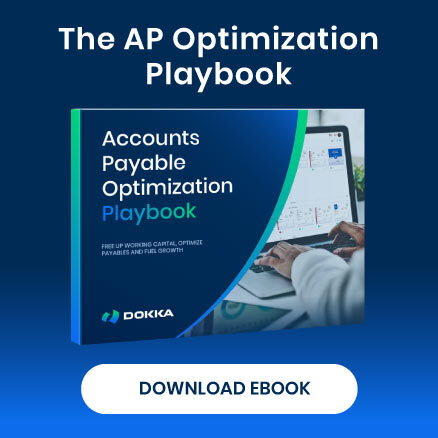As technology becomes increasingly sophisticated, fraud perpetrators find it easier than ever to forge signatures, generate false invoices, and manipulate accounting software. This is especially dangerous if you’re not using AP automation software that prevents fraud (like DOKKA).
Accounts payable fraud is one of the most common (and costly) threats facing organizations today. Whether it involves a fake invoice, a duplicate payment, or an internal collusion scheme, AP fraud can drain financial resources, damage reputations, and erode trust.
That is why companies must remain vigilant in protecting their financial systems, implementing strict procedures for verifying payments and account entries, and conducting regular internal audits.
Lack of proper security exposes companies to exploitation within their AP departments, potentially costing them thousands of dollars.
Fortunately, with the right combination of controls, technology, and awareness, they can significantly reduce their exposure to risk.
What Is Accounts Payable Fraud?
Accounts payable fraud is a form of financial fraud that targets a company’s accounts payable function. It occurs when an individual (whether an internal employee or an external actor) manipulates the payment process for personal gain.
Typical examples include billing schemes, check fraud, reimbursement fraud, fake invoices or vendor accounts, altering payment details, and embezzling funds intended for legitimate purposes.
Spotting AP fraud can be challenging because it often involves subtle manipulation of financial records and documentation, making fraudulent activity appear legitimate at first glance.
How Does Accounts Payable Fraud Work?
It typically occurs when an individual or group within a company exploits weaknesses in the AP process. Employees in accounting, purchasing, or other departments with access to financial systems, payment approvals, or vendor management often carry out such schemes. Fraudsters take advantage of gaps in controls, oversight, and verification to manipulate payments for personal gain.
Understanding common methods of AP fraud enables organizations to identify vulnerabilities and implement stronger safeguards.
Common Methods of AP Fraud
- Billing Schemes
- Check Fraud
- ACH Fraud
- Reimbursement Fraud
- Fake Vendors
- Altered Payments
- Collusion / Kickback Schemes
1) Billing Schemes
Billing schemes involve submitting false or inflated invoices for payment. Fraudsters may set up shell companies to send fictitious invoices or overcharge for legitimate services.
Examples include:
- Phantom billing: Charging for goods or services that were never delivered.
- Inflated billing: Overstating the value of legitimate goods or services.
These schemes often go unnoticed in large organizations that process thousands of invoices each month, making automated detection and verification essential.
2) Check Fraud
Check fraud involves manipulating checks to divert company funds.
Common methods include:
- Altering payee names or payment amounts.
- Forging signatures.
- Creating fake checks.
- Stealing or misusing legitimate checks.
Manual check processing and limited reconciliation increase organizational vulnerability to these schemes.
3) ACH Fraud
ACH fraud exploits electronic payment systems to transfer funds illegally.
Fraudsters may use:
- Phishing attacks or stolen login credentials
- Malware to infiltrate corporate systems
- Unauthorized instructions to transfer funds
Prevention: Implement multi-factor authentication, secure login protocols, antivirus software, and strict payment authorization workflows.
4) Reimbursement Fraud
Employees carry out this type of fraud by submitting false or inflated expense claims.
Examples include:
- Creating fake receipts or invoices for non-existent expenses
- Inflating legitimate expenses to receive higher reimbursement
- Submitting multiple claims for the same expense
- Using personal accounts or fabricated transactions to manipulate AP processes
Regular expense audits and strict policy enforcement are essential for prevention.
5) Fake Vendors
Fake vendor schemes involve creating fictitious suppliers in the accounts payable system. Fraudsters submit invoices for goods or services that were never provided.
Key tactics:
- Establishing shell companies to receive payments.
- Exploiting weak vendor verification procedures.
- Using legitimate-sounding vendor names to avoid suspicion.
Fake vendors are often the mechanism behind phantom billing or inflated invoices.
6) Altered Payments
Altered payments method involves manipulating legitimate invoices or payment details to redirect funds.
Common tactics include:
- Changing payee names or bank account information.
- Adjusting payment amounts to siphon excess funds.
- Modifying payment dates to conceal fraud.
Multi-step verification and segregation of duties are critical in preventing this type of fraud.
7) Collusion / Kickback Schemes
Collusion occurs when employees work with vendors or third parties to commit fraud.
Kickback schemes are a specific type of collusion in which:
- Vendors inflate invoices or charge for non-existent goods.
- Employees approve these invoices in exchange for a share of the illicit gains.
Detection of these schemes is particularly difficult without independent audits, strong oversight, and ongoing transaction monitoring.
Causes, Risks, and Warning Signs of Accounts Payable Fraud
Fraud often thrives where internal controls are weak, processes are inconsistent, or oversight is limited. Identifying vulnerabilities and warning signs allows companies to act before losses occur.
5 Common Root Causes and Vulnerabilities
- Poor segregation of duties: When the same employee can create, approve, and process payments, manipulating transactions without detection becomes easier.
- Inadequate vendor verification: Failing to verify vendor legitimacy opens the door to fake supplier accounts or shell companies. New vendors should always be validated with official documentation, tax IDs, and business registration checks.
- Manual and paper-based processes: Invoices processed manually or on spreadsheets are harder to monitor and easier to alter. Manual systems increase the likelihood of duplicate payments, human error, and overlooked irregularities.
- Weak approval hierarchies: Relying on a single approver or informal approval processes creates gaps that fraudsters can exploit. Formal multi-level approvals are essential for high-value or unusual payments.
- Limited oversight and audits: Organizations that conduct infrequent audits or reconciliations are more susceptible to fraud. Regular reviews of invoices, vendor accounts, and payment history help detect anomalies early.
Key Warning Signs and Red Flags
Even with strong controls, fraud can occur if irregularities go unnoticed. Warning signs may include:
- Unexplained changes in vendor information: Sudden changes to bank accounts, addresses, or contact details may indicate payment diversion schemes.
- Duplicate or altered Invoices: Repeated invoices for the same service, inflated amounts, or minor alterations in invoice numbers can signal fraud.
- Unusual payment patterns: Payments outside normal schedules, unusually high amounts, or recurring “special” payments warrant review.
- Missing or inconsistent documentation: Lack of proper supporting documents, incomplete invoices, or fabricated receipts can indicate false claims or reimbursements.
- Resistance to audits or verification: Employees or vendors who avoid scrutiny or delay providing documentation may be concealing fraudulent activity.
- Abnormal or repetitive discrepancies: Consistent discrepancies between invoices and supporting records suggest manipulation or repeated errors.
Awareness of vulnerabilities and warning signs is the first line of defense. Companies that fail to recognize these root causes and red flags risk significant financial loss, regulatory issues, and reputational damage.
Proactive measures, such as including segregating duties, enforcing multi-level approvals, conducting regular audits, and implementing technology solutions can detect early signs of fraud, preventing minor irregularities from escalating into costly incidents.
How AP Automation Can Help Prevent Accounts Payable Fraud
Preventing AP fraud requires more than manual checks and occasional audits.
Modern AP automation solutions offer a proactive approach, reducing human error, increasing transparency, and ensuring consistent adherence to internal controls.
Digitizing invoice processing, payment approvals, and recordkeeping makes it significantly harder for fraudulent activities to go undetected.
Key Benefits of AP Automation in Fraud Prevention
- Improved Accuracy and Reduced Errors
Manual entry of invoices, payment amounts, or vendor details increases the risk of mistakes and creates opportunities for fraud. AP automation minimizes these risks through automatic extraction of invoice data, matching it against purchase orders, and flagging inconsistencies. Each payment is verified before processing, reducing both accidental and intentional errors.
- Enhanced Security and Access Controls
Automation platforms allow companies to implement role-based permissions so that no single employee has full control over the entire AP process. Multi-level approval workflows prevent unauthorized payments and maintain a clear audit trail for every transaction, limiting opportunities for internal fraud and making it easier to detect suspicious activity.
- Real-Time Visibility and Reporting
AP automation provides comprehensive, real-time insights into all accounts payable activity. Centralized monitoring of invoices, approvals, and payments enables managers to quickly identify unusual patterns or irregular transactions. Automation also delivers instant reporting on vendor activity, helping detect duplicate invoices, altered payment amounts, or unauthorized vendors before they cause problems.
- Fraud Detection Features
Many modern AP automation solutions include built-in fraud detection algorithms that flag anomalies such as duplicate invoices, unusual payment amounts, or new vendor entries. Alerts to potential fraud in real time allow staff to act promptly and prevent financial losses.
Why DOKKA Is The Best Solution for AP Fraud Prevention
DOKKA is a cutting-edge AP automation platform designed to streamline invoice management while enhancing security and compliance.
Organizations using DOKKA can:
1) Automate Invoice Capture and Matching
AI extracts data from invoices, matches it against purchase orders and contracts, and highlights discrepancies automatically, reducing manual intervention and preventing fraudulent invoices from slipping through.
2) Enforce Multi-Level Approvals
DOKKA’s workflow engine supports approval hierarchies, ensuring high-value or unusual payments require multiple sign-offs.
3) Maintain an Immutable Audit Trail
Every invoice, approval, and payment is recorded, creating a transparent, auditable record that protects against internal and external fraud.
4) Monitor Vendor Activity Continuously
Vendor activity, including changes to payment details and invoice submission patterns, is tracked to spot anomalies before payments are processed.
5) Integrate Seamlessly with ERPs
DOKKA connects to accounting and ERP platforms, providing a unified view of AP operations and strengthening financial controls.
DOKKA helps organizations minimize AP fraud while enhancing efficiency, accuracy, and visibility in the accounts payable process. Schedule a free demo to see how DOKKA can support your AP team.




